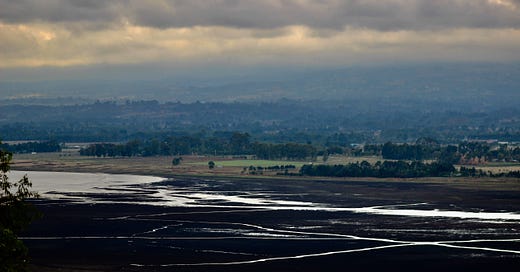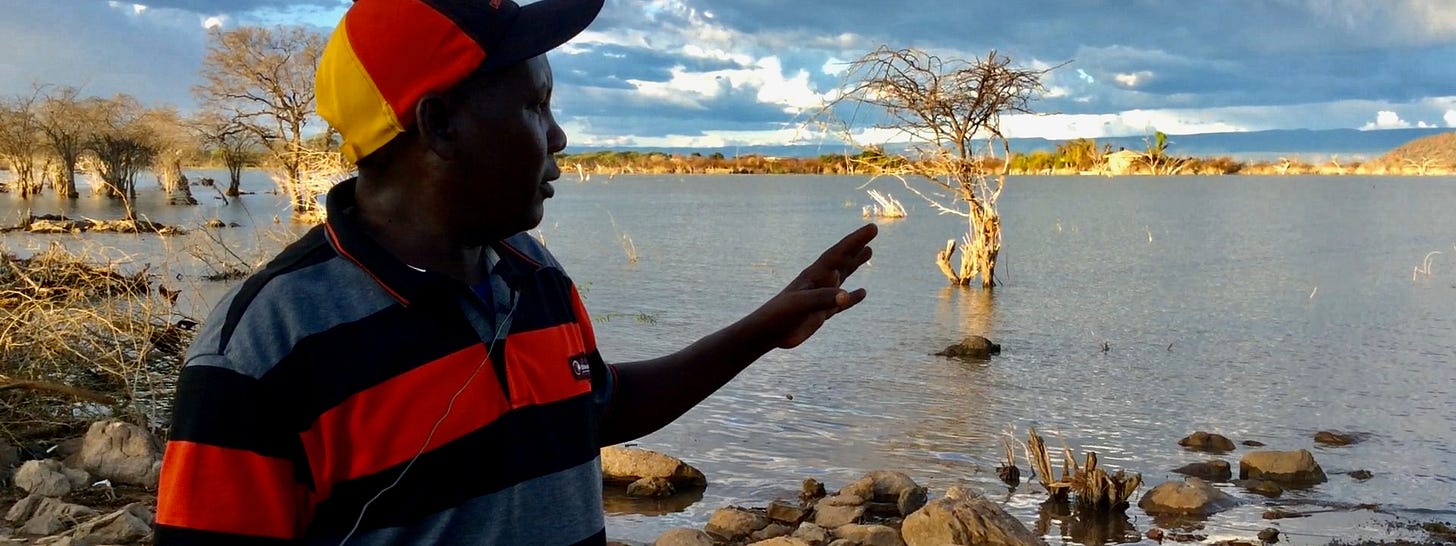VIEW
Analysis and global perspectives in health, development, planet.
It was almost dusk by the time we pulled up near the water.
I walked the short distance from the car to the shores of lake Baringo, equipment at the ready. We only had a few minutes before the soft afternoon light would fade into evening, too weak to work for the camera shot.
As I rushed to set up, Samuel, our guide for the day, pointed to what I estimated was about 1 km into the lake. That’s where the water’s boundary normally stands, he said. A derelict structure just next to us—a grand building by comparison with the poor settlements around the area—was a hotel that had gone out of business by the recent surge of water, he said.
We weren’t there to talk about flooding. There wasn’t much time. By the time we were done with the interview, and a few chatty local men, there was not even time for a decent photograph.
But the exchange took me back to a longform piece spotted in the Guardian just a few weeks ago, where journalist Carey Baraka has already done some probing into the mysterious expansion of lakes in Kenya’s Great Rift valley—what he calls an environmental disaster that’s displacing hundreds of thousands of people.
It turns out my guesstimate was too conservative: the lake’s boundary has moved by 2km, according to Baraka.
In March 2020, he reports, the flooding completely submerged 11 schools in Marigat, the rural town that was our base for the trip. This is a part of Kenya where poverty levels are high: more than 50% across Baringo county, with people in urban areas generally worse off.
Baraka’s piece explores a few theories as to why Baringo and other Great Lakes are flooding—higher river volumes due to climate change, tectonic plates moving apart, a new underground aquifer. But there’s no explanation as yet. A report published by the Kenyan government in October 2021 puts emphasis on greater rainfall caused by climate change, combined with human activities such as deforestation.
These kinds of pressures are often linked with flooding—but that’s not always how it turns out.
A few days later I found myself some 185 km southeast of Baringo, stood on a hill and looking down on another lake showing signs of trouble.
We arrived at dusk, once again. Some ten minutes left for a few clicks of the shutter this time. The light was just enough to catch strands of water, glistening marks of lost territory.
This is lake Ol’Bolosat, and it’s slowly vanishing.
A highland lake on the edge of the Great Rift valley, in Kenya’s Central Province, its waters stretch across a catchment area of some 4,800 km2. But the water boundary is receding.
Researchers believe that’s down to a mix of pressures that stem from human activity. The number of people moving closer to its shores has been growing, a result of both population growth and internal migration following political violence in 2008. This creates a high demand for water, as well as land for homes and farming. As agriculture intensifies, soils become loose and cause siltation, which reduces the lake’s depth. Infrastructure and clearing of vegetation add to the pressures by drying up the springs and streams flowing into the lake.
Part of the problem, of course, is that land and water resources are poorly managed. That was the topic of a three-day discussion among the researchers, civil society leaders and policymakers I joined for this excursion.
But the sight of lake Ol’Bolosat was a reality check even for those already in the know.
The leader of a community based on the lower side of the lake—pastoralists who depend entirely on the land for their livelihoods—told me he now has a much better sense of how seriously this will impact the grazing land available to his people over the next decade. A policymaker said she’s now more aware of how urgent it is to do better on management, but persuading colleagues who haven’t seen the impact with their own eyes would be part of the challenge of doing something about it.
Whether by flooding or drying up, the great lakes are sending a warning. We know that water is essential to life. We also know that competition for scarce water resources tends to breed conflict. Although water resources vary across Kenya’s diverse landscape, the country is among the least water-secure in the whole of Africa.
The task of managing water effectively is far from straight-forward. The challenges I heard about are too many to list—from conflicting demands on land to disparate pieces of legislation, poor implementation, political interests, even a lack of clarity over what ‘sustainable land use’ means. There was no satisfying conclusion to the proceedings, and I won’t make one up for the sake of it.
I’d like to think that bearing witness and waking up to the urgency are steps in the right direction.
Note: WorldWise Briefings (Pro) have been on hold while I’ve been on the road—our news highlights will return with the next edition!
From the week’s global soundtrack 🌐
✔️ Independent and reader-funded
🤍 Liked this WorldWise email?
Tap the heart button. Forward to a friend. Comment or reply. Follow on Twitter.
📩 Help keep WorldWise going
If you support global journalism, please consider a subscription or one-time donation.





